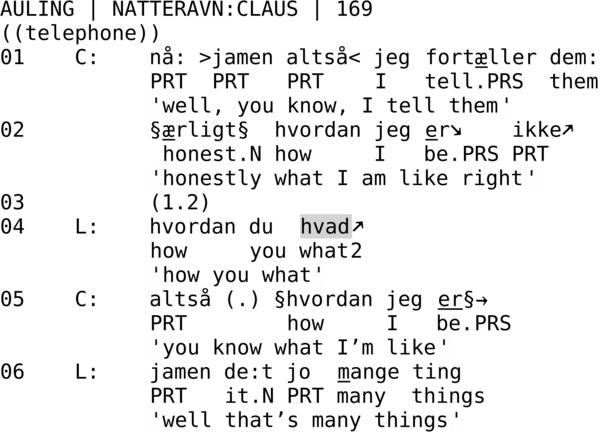Hvad (what2)
The word hvad (‘what’) in written Danish covers at least four different forms with various functions in Danish talk-ininteraction. One of these forms is hvad [væð].
Hvad has various functions and overlaps in this way with both the pronoun hva (what1) and the open class repair initiator hvar (what3). Hvad’s most frequent function is to initiate repair , either as an independent utterance or as part of a larger syntactic construction. If an utterance contains a problem, e.g. that it is hard to hear or hard to understand, one can repair the problem. The initiation of the repair can come from both the person whose utterance contained the problem (self-initiated repair) or from another participant (other-initiated repair).
Hvad initiates other-initiated repair as in the extract below where Claus (C) has called the radio show Natteravnen which is hosted by Lars (L).

After a long pause, Lars asks Claus about his utterance with hvordan du hvad ’how you what’ in the two first lines. This example shows us two things. First of all, hvad can be used to point out a specific problem, in comparison to the repair marker hvar, which does not specify the problem. Lars shows by repeating a part of Claus’ utterance that he has heard the utterance and inserts hvad where the problem is. Furthermore, this repair initiator seems to be used with problems which are more than just purely auditory problems. The pause in line 3 would have been remarkably shorter if the problem was purely auditory and besides showing in line 4 that he has heard the utterance, Lars’ answers in line 6 indicates – with a slight irritated initiating jamen – that the problem has been the vague phrasing hvordan jeg er ’how I am/what I’m like’ and not an auditory problem.
In the following example hvad also initiates repair, but in the interjection form similar to hvar. In the example two people are playing the quiz-game Jeopardy and the questioner, C, mispronounces a difficult word, which prompt s the answerer, A, to utter hvad after a short pause, and immediately the questioner (in the quiz-context) corrects the stress of the word.

Thus, hvad can function as a pronoun as well as an interjection. Furthermore, it can be used as a pronoun in the beginning of a sentence, with a function similar to hva (what1) to request information but seems to be more marked than hva in this position. It can be marked both phonetically (e.g. with a certain stress or volume) or contextually (e.g. with an irritated tone of voice). Finally, hvad is featured in the set construction with eller, and it is used to request confirmation of a previous utterance. For more on this construction see eller hva(d).
Sources and further reading
Brøcker et al. (2012). A thorough run-through of four phenomena in Danish talk in interaction, including the spoken language’ different variations of the written language hvad.
Drew (1997). An article which explains repair markers, especially the ones which cannot point to a specific problem (open class-repair markers).
Hansen and Heltoft (2011: 606). The major work on Danish grammar. On page 606 some of the functions of hvad are described, also in the spoken language, though still insufficient in comparison to the description on this website.
Jørgensen (2015). A more elaborating description of the different variants of hvad in the spoken language.
Jørgensen (2011b). Short, popular scientific article on sprogmuseet.dk on the four spoken language variants of hvad.
Sidnell (2010: 118). An introductory book on conversation analysis. The specific page gives a fast overview of the different kinds of repair markers.
Related entries
The Building Blocks of Talk-in-interaction > Word classes/Parts of speech > Interjections and particles
The Building Blocks of Talk-in-interaction > Word classes/Parts of speech > Pronouns
Social Actions > Questions > Request for information
